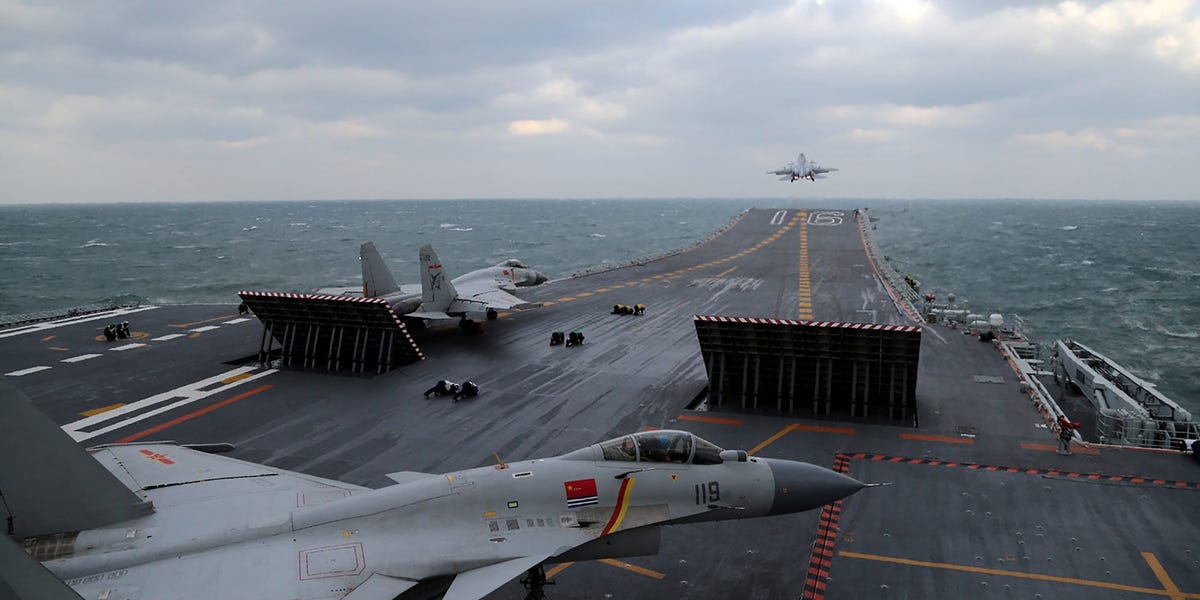
Take a look at our newest merchandise
- China seems to be erecting buildings within the Yellow Sea between China and the Korean peninsula.
- China’s playbook for dominating neighbors consists of island reclamation and maritime buildings.
- The Yellow Sea is of historic significance to China, a former South Korea diplomat argues.
With China’s neighbors already nervous about its territorial ambitions, a brand new flashpoint has emerged between China and South Korea.
China seems to be erecting buildings within the Yellow Sea, situated between China and the Korean peninsula. South Korea fears this may very well be a prelude to Beijing asserting sovereignty over the 150,000-square-mile physique of water, which is wealthy in fish and has oil and gasoline deposits. This energy play would have implications for the US.
South Korean spy satellites detected the Chinese language construction in December, in line with the Chosun Every day, a South Korean newspaper. “The set up, a cell metal framework exceeding 50 meters in diameter and top, was noticed within the disputed waters,” the newspaper stated. China erected two related buildings in 2024, eliciting South Korean protests.
“China has reportedly described the buildings as ‘fishing assist services,’ dismissing issues,” the Chosun Every day famous. “South Korean officers consider China plans to put in as much as 12 such buildings.”
To explain the scenario as sophisticated could be an understatement. The Yellow Sea is within the unique financial zone, or EEZ, of each China and South Korea. Beneath worldwide legislation, an EEZ permits nations to say jurisdiction over financial sources out to 200 miles from their coastlines (at 4.3 million sq. miles, the US has the second-largest EEZ on the earth after France). China has constructed islands to bolster its doubtful claims to many of the South China Sea and challenged the EEZ rights of neighbors just like the Philippines.
Requested for touch upon the sighted building within the Yellow Sea, Liu Pengyu, a spokeman for the Chinese language Embassy within the US, stated “I’m not conscious of the particular scenario, however so far as I do know, China and the [Republic of Korea] are pushing ahead negotiations on maritime delimitation and have established a dialogue and cooperation mechanism on maritime affairs. The 2 sides keep sound communication on maritime points.”
Not surprisingly, in a world the place oceanic sources — similar to oil and fish — are coveted like buried treasure, disputes over EEZs should not unusual. Within the Mediterranean, for instance, Greece and Turkey are at odds over power deposits.
On this case, South Korea argues that the boundary between the conflicting EEZs ought to be drawn down the center of the Yellow Sea. Nonetheless, “China maintains that the maritime boundary ought to be proportional to its longer shoreline and bigger inhabitants,” in line with the Nationwide Bureau of Asian Analysis, a US suppose tank.
In 2001, China and South Korea created the Provisional Measures Zone, or PMZ, which covers the world of their overlapping EEZs. Along with delineating joint fishing rights and fisheries administration, the PMZ additionally mandated that each nations would regularly limit fishing to their respective EEZs. As a substitute, South Korea has lengthy complained about Chinese language vessels fishing within the Korean aspect, which has led to South Korean ships firing on Chinese language fishermen.
Have been this merely a fishing dispute, the Yellow Sea would possibly resemble the notorious “Cod Wars” between Britain and Iceland, which was an financial battle somewhat than a capturing warfare. However Korea, and China’s different neighbors, worry that Beijing is trawling for greater than fish.
Tensions between South Korea and China danger drawing within the US, which has a mutual protection pact with South Korea and bases 28,000 troops there.
Erecting everlasting maritime buildings has turn into the calling card saying Chinese language claims to the Western Pacific. Most infamous are the unreal islands China has created within the South China Sea, which function air and naval bases to claim Beijing’s claims to sovereignty over mineral-rich waters additionally claimed by Vietnam, Malaysia, the Philippines and different Southeast Asian nations.
These Chinese language outposts unfold like inkspots. For instance, Beijing just lately declared the waters round Scarborough Shoal — disputed reefs claimed by China and the Philippines — as territorial waters. In impact, these installations function the maritime equal of shoes on the bottom to claim a bodily presence in an space.
The Yellow Sea hasn’t acquired as a lot world consideration as flashpoints within the South China Sea, or China’s simmering dispute over Japanese-controlled islands within the East China Sea. However the Yellow Sea is sort of essential to China, which is delicate about its coastal areas, Sang Hun Seok, a former South Korean diplomat, argued in an essay for the Royal United Providers Institute, a British suppose tank.
“From China’s strategic viewpoint, solidifying its littoral protection and increasing the areas the place it could possibly take pleasure in freedom of motion are critically vital for its safety,” Sang Hun wrote.
There’s additionally a psychological sensitivity rooted in Chinese language historical past during the last 200 years, by which China misplaced a number of wars and had its territory seized by colonial powers similar to Nice Britain, Japan and Russia. “Most crucial battles in Northeast Asia for the reason that nineteenth century — a interval China sees as a quick deviation from its rightful historic trajectory — have been fought within the neighborhood of the Yellow Sea,” Sang Hun wrote.
Except South Korea and its allies can cease China from erecting outposts within the Yellow Sea, “the strategic stability within the area will in the end shift in China’s favor, leaving the allies’ freedom of motion restricted to a fraction of the Yellow Sea,” Sang Hun warned. “This gradual shift would first weaken the protection posture for vital army belongings alongside the west coast of the Korean Peninsula, regularly adopted by Kyushu, Okinawa and in the end Taiwan.”
Michael Peck is a protection author whose work has appeared in Forbes, Protection Information, International Coverage journal, and different publications. He holds an MA in political science from Rutgers Univ. Observe him on Twitter and LinkedIn.





![[2024] MSI Aegis R2 C14NUF9-829US (Intel Core i9-14900F, 128GB DDR5 RAM, 2X 2TB NVMe SSD, NVIDIA GeForce RTX 4070 Ti Super, Windows 11) Gaming Desktop PC](https://m.media-amazon.com/images/I/81i1KVslX4L._AC_SL1500_.jpg)







